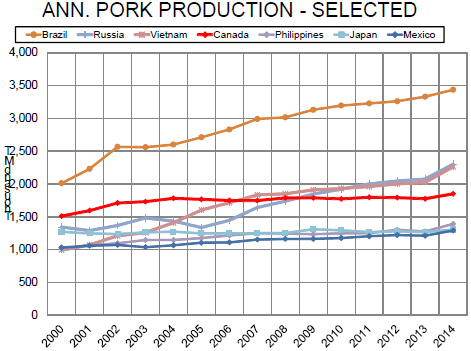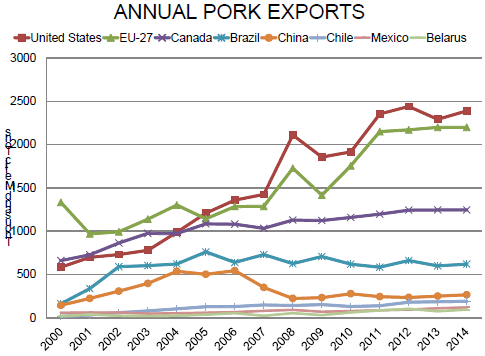



CME: Impact of US, Canada PED Situation on World Pork Markets
US - How will the PEDv situation in the US and Canada impact world pork supplies and markets? Since determining the size of the losses in the two countries is difficult enough, this question may be unanswerable but it deserves a bit of thought given the size and importance of trade in pork and pork products, write Steve Meyer and Len Steiner.As with many things, context is critically important here. And "context" in the pork industry — and a lot of other things, for that matter — really means "China". The chart below shows historical pork production data by country as well as 2013 projections and 2014 forecasts from USDA’s Foreign Agricultural Service. As can be seen, China’s pork output dwarfs all others, more than doubling then second-place European Union. FAS’s forecast for 2014 Chinese pork production is 54.7 million metric tons, 5.2 per cent larger than in 2013. The forecast INCREASE of China’s output this year is large than the forecast TOTAL PRODUCTION of every country other than the U.S,, the EU and Brazil! The scaling impact of China on the chart leaves all other countries in a cluster near the X-axis — and that cluster includes Canada, the world’s third largest pork exporter.

But there is considerable action among the smaller countries. The following chart shows the remainder of the ten largest pork producing countries after China, the EU and the US have been removed. FAS forecasts higher pork output for all of these countries in 2014. Viet Nam and Russia lead the growth list in both unit and percentage terms. Viet Nam’s pork production is forecast to be 2.26 million metric tons this year, 225,000 (11.6 per cent) larger than last year. Russia’s output is forecast to grow by 225,000 metric tons (10.8 per cent) to reach 2.3 million metric tons. Russia’s pork production has increased by over 50 per cent since 2006 as part of a specific plan to increase self-sufficiency of meat and poultry proteins. We (and most observers) believe Russia’s frequent trade actions blocking various imports are a key part of that plan.

Of course, Brazil is the largest of these "other" countries and ranks fourth in the list of pork producing nations. Its pork output has grown very steadily since 2004 and is forecast to increase by another 3.2 per cent this year to 3.435 million metric tons. That growth fits the "Brazil is an agricultural juggernaut" view of the past few years and, for that matter, the future. The country has an amazing set of natural resources that have not yet been fully tapped. It can be even more important in the future.
But the curious fact about Brazil is that its pork exports have grown very little. See the chart of pork exports below. Though its pork production has doubled since 2002, its 2013 pork exports (600,000 metric tons) ave barely higher than in that year and are forecast to increase to only 620,000 metric tons this year, a level 110,000 metric tons lower than its peak in 2007. The reason, of course, is that income levels in Brazil have risen sharply, allowing Brazilians to consumer more and more of the higher pork output. It’s difficult to export product if your own consumers will pay more for it!

So where does this leave the US and Canada in light of PEDv? FAS had forecast US output to grow by 345,000 metric tons (3.3 per cent) this year. That fits well with what was expected to be a slightly larger breeding herd, our usual two per cent litter size growth and a small increase in weights. But the litter size growth is very likely gone and USDA says, curiously, that the breeding herd was actually smaller on 1 December. Weights are playing their role in spades but it appears now that the 3.3 per cent growth is gone and US output may well be flat versus 2013. If so, it may be difficult to increase US exports by the forecast 98,000 metric tons or 4.3 per cent.
It is too early to predict how PEDv may impact Canada’s output and exports but given the US’s experience, one has to think both measures for 2013 are in some degree of peril.








